2022 HYUNDAI SANTA CRUZ air condition
[x] Cancel search: air conditionPage 82 of 598
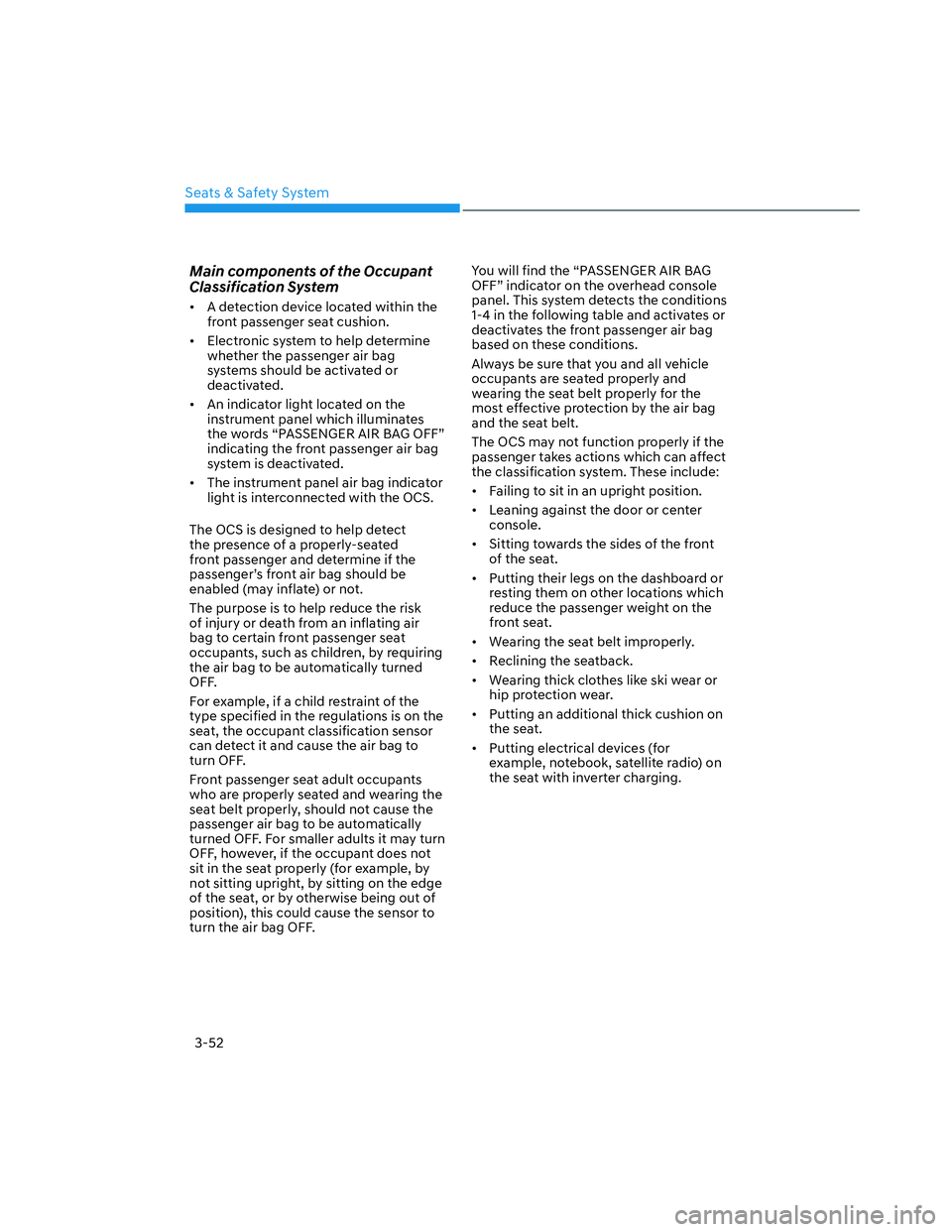
Seats & Safety System
3-52
Main components of the Occupant
Classification System
• A detection device located within the
front passenger seat cushion.
• Electronic system to help determine
whether the passenger air bag
systems should be activated or
deactivated.
• An indicator light located on the
instrument panel which illuminates
the words “PASSENGER AIR BAG OFF”
indicating the front passenger air bag
system is deactivated.
• The instrument panel air bag indicator
light is interconnected with the OCS.
The OCS is designed to help detect
the presence of a properly-seated
front passenger and determine if the
passenger’s front air bag should be
enabled (may inflate) or not.
The purpose is to help reduce the risk
of injury or death from an inflating air
bag to certain front passenger seat
occupants, such as children, by requiring
the air bag to be automatically turned
OFF.
For example, if a child restraint of the
type specified in the regulations is on the
seat, the occupant classification sensor
can detect it and cause the air bag to
turn OFF.
Front passenger seat adult occupants
who are properly seated and wearing the
seat belt properly, should not cause the
passenger air bag to be automatically
turned OFF. For smaller adults it may turn
OFF, however, if the occupant does not
sit in the seat properly (for example, by
not sitting upright, by sitting on the edge
of the seat, or by otherwise being out of
position), this could cause the sensor to
turn the air bag OFF.You will find the “PASSENGER AIR BAG
OFF” indicator on the overhead console
panel. This system detects the conditions
1-4 in the following table and activates or
deactivates the front passenger air bag
based on these conditions.
Always be sure that you and all vehicle
occupants are seated properly and
wearing the seat belt properly for the
most effective protection by the air bag
and the seat belt.
The OCS may not function properly if the
passenger takes actions which can affect
the classification system. These include:
• Failing to sit in an upright position.
• Leaning against the door or center
console.
• Sitting towards the sides of the front
of the seat.
• Putting their legs on the dashboard or
resting them on other locations which
reduce the passenger weight on the
front seat.
• Wearing the seat belt improperly.
• Reclining the seatback.
• Wearing thick clothes like ski wear or
hip protection wear.
• Putting an additional thick cushion on
the seat.
• Putting electrical devices (for
example, notebook, satellite radio) on
the seat with inverter charging.
Page 83 of 598
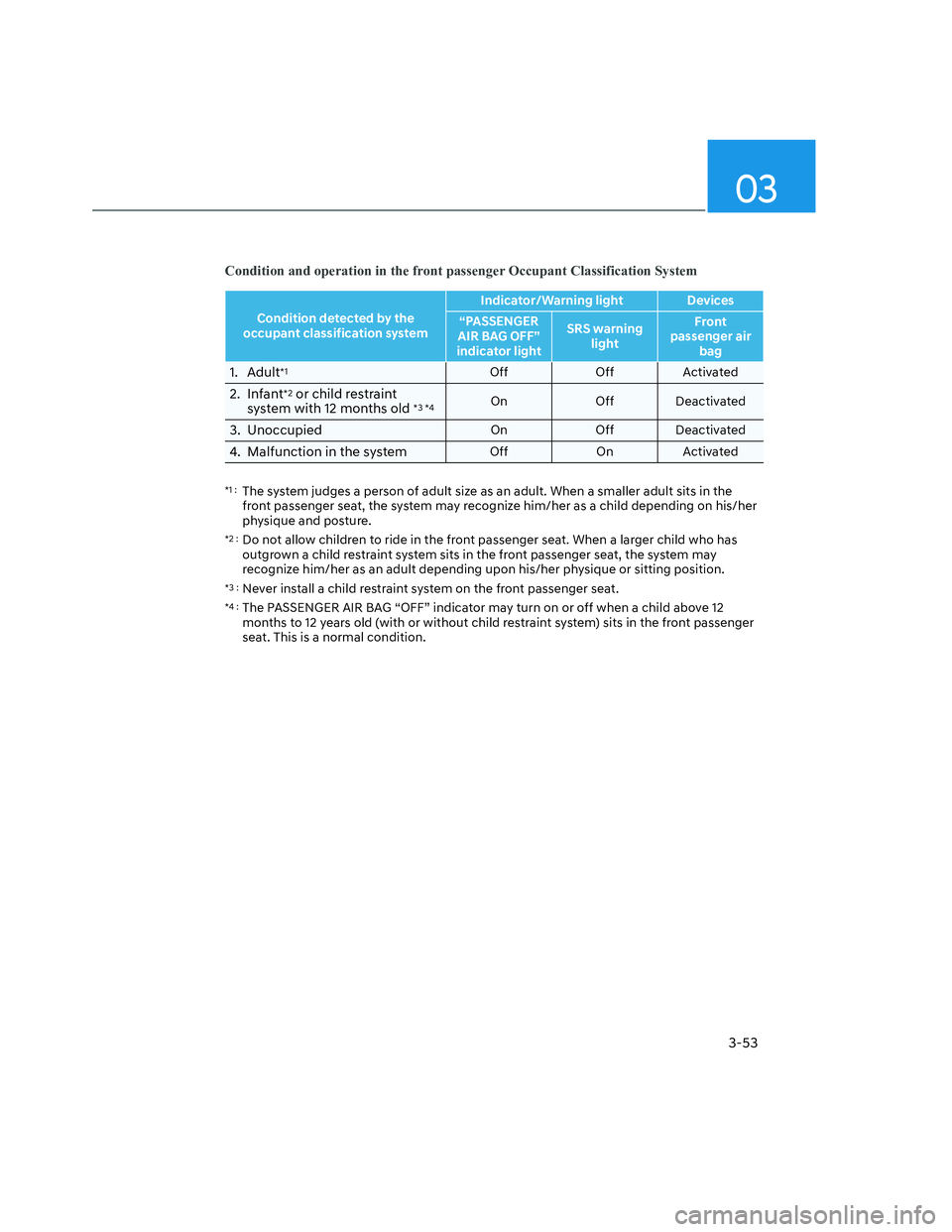
03
3-53
Condition and operation in the front passenger Occupant Classification System
Condition detected by the
occupant classification systemIndicator/Warning light Devices
“PASSENGER
AIR BAG OFF”
indicator lightSRS warning
lightFront
passenger air
bag
1. Adult*1Off Off Activated
2. Infant*2 or child restraint
system with 12 months old *3 *4On Off Deactivated
3. UnoccupiedOn Off Deactivated
4. Malfunction in the systemOff On Activated
*1 : The system judges a person of adult size as an adult. When a smaller adult sits in the
front passenger seat, the system may recognize him/her as a child depending on his/her
physique and posture.
*2 : Do not allow children to ride in the front passenger seat. When a larger child who has
outgrown a child restraint system sits in the front passenger seat, the system may
recognize him/her as an adult depending upon his/her physique or sitting position.
*3 : Never install a child restraint system on the front passenger seat.
*4 : The PASSENGER AIR BAG “OFF” indicator may turn on or off when a child above 12
months to 12 years old (with or without child restraint system) sits in the front passenger
seat. This is a normal condition.
Page 89 of 598
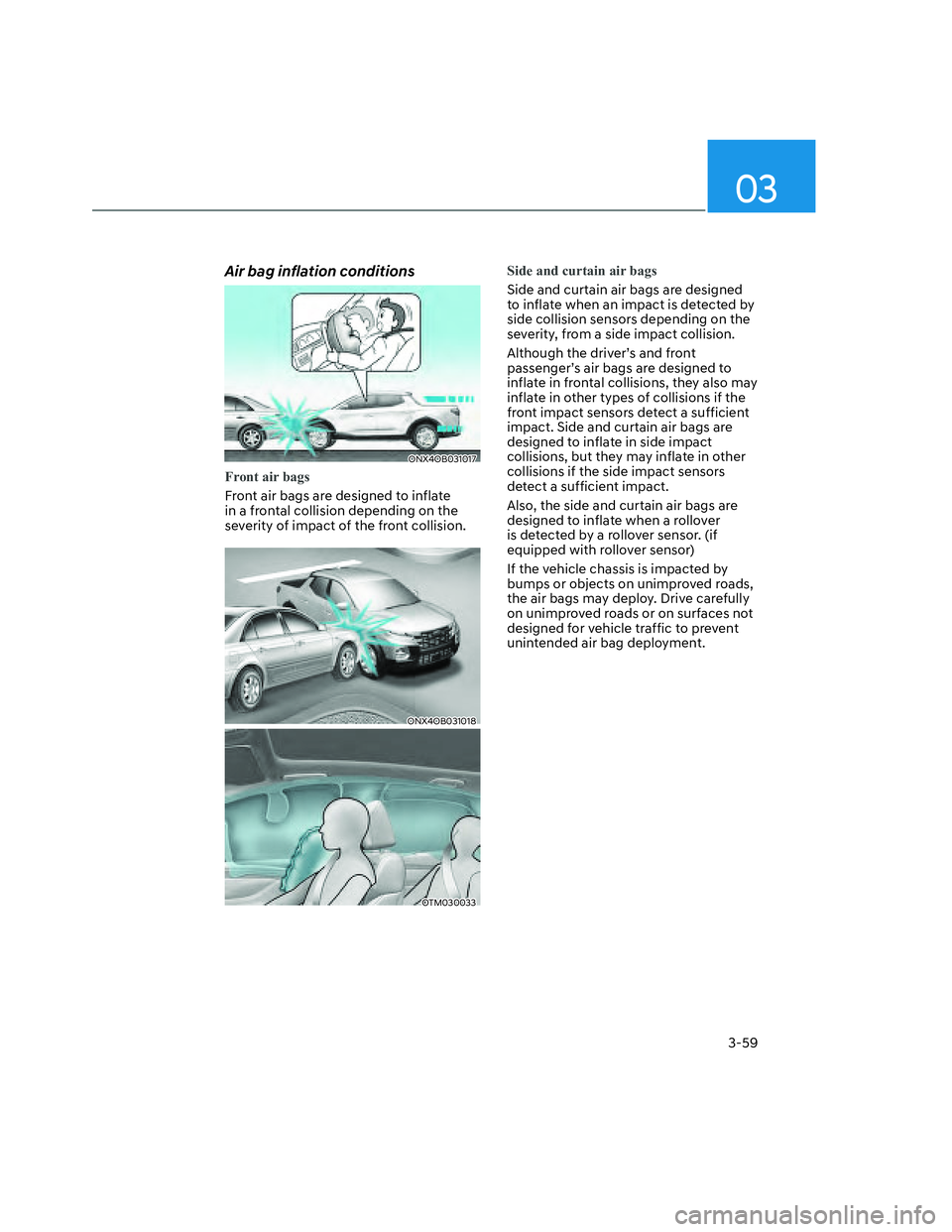
03
3-59
Air bag inflation conditions
ONX4OB031017ONX4OB031017
Front air bags
Front air bags are designed to inflate
in a frontal collision depending on the
severity of impact of the front collision.
ONX4OB031018ONX4OB031018
OTM030033OTM030033
Side and curtain air bags
Side and curtain air bags are designed
to inflate when an impact is detected by
side collision sensors depending on the
severity, from a side impact collision.
Although the driver’s and front
passenger’s air bags are designed to
inflate in frontal collisions, they also may
inflate in other types of collisions if the
front impact sensors detect a sufficient
impact. Side and curtain air bags are
designed to inflate in side impact
collisions, but they may inflate in other
collisions if the side impact sensors
detect a sufficient impact.
Also, the side and curtain air bags are
designed to inflate when a rollover
is detected by a rollover sensor. (if
equipped with rollover sensor)
If the vehicle chassis is impacted by
bumps or objects on unimproved roads,
the air bags may deploy. Drive carefully
on unimproved roads or on surfaces not
designed for vehicle traffic to prevent
unintended air bag deployment.
Page 90 of 598
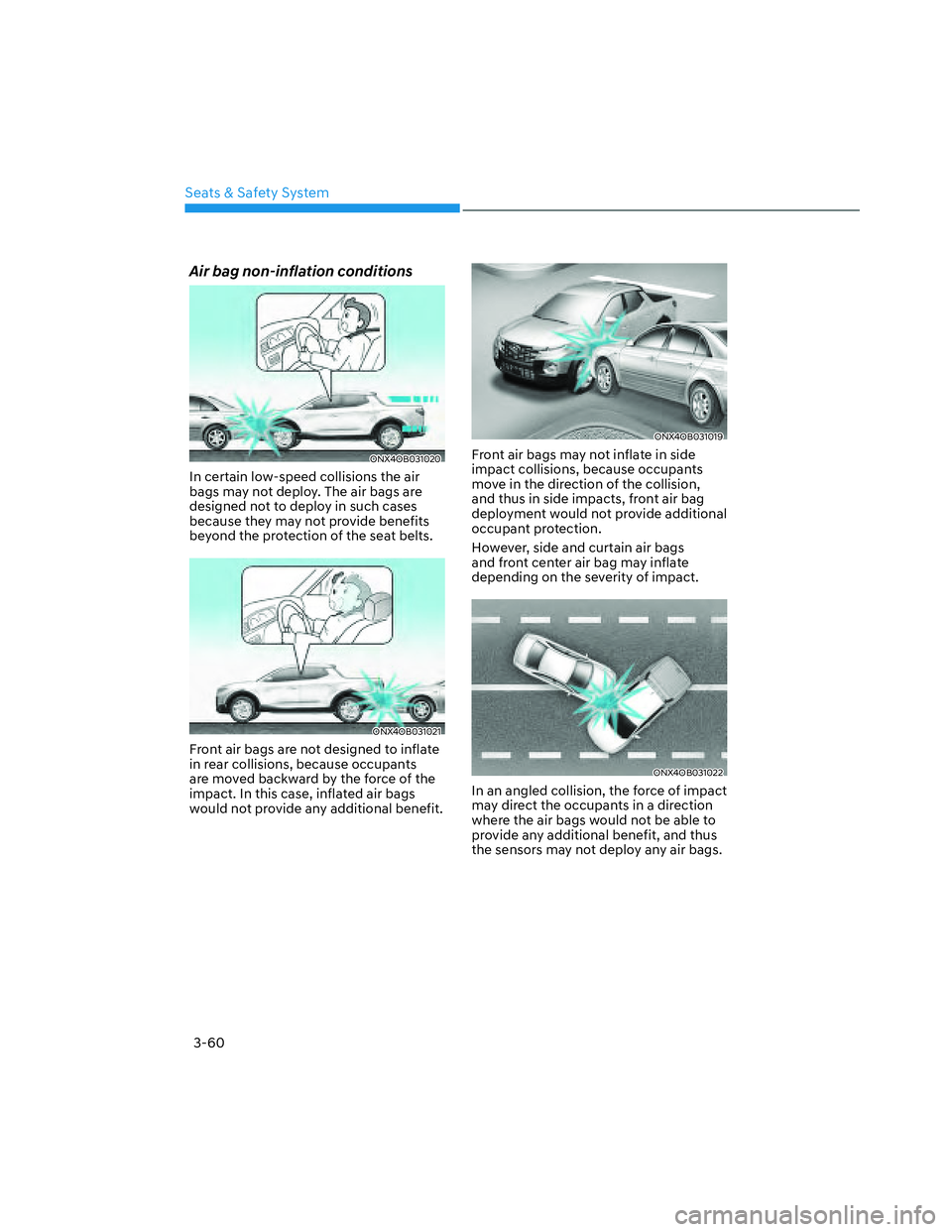
Seats & Safety System
3-60
Air bag non-inflation conditions
ONX4OB031020ONX4OB031020
In certain low-speed collisions the air
bags may not deploy. The air bags are
designed not to deploy in such cases
because they may not provide benefits
beyond the protection of the seat belts.
ONX4OB031021ONX4OB031021
Front air bags are not designed to inflate
in rear collisions, because occupants
are moved backward by the force of the
impact. In this case, inflated air bags
would not provide any additional benefit.
ONX4OB031019ONX4OB031019
Front air bags may not inflate in side
impact collisions, because occupants
move in the direction of the collision,
and thus in side impacts, front air bag
deployment would not provide additional
occupant protection.
However, side and curtain air bags
and front center air bag may inflate
depending on the severity of impact.
ONX4OB031022ONX4OB031022
In an angled collision, the force of impact
may direct the occupants in a direction
where the air bags would not be able to
provide any additional benefit, and thus
the sensors may not deploy any air bags.
Page 138 of 598
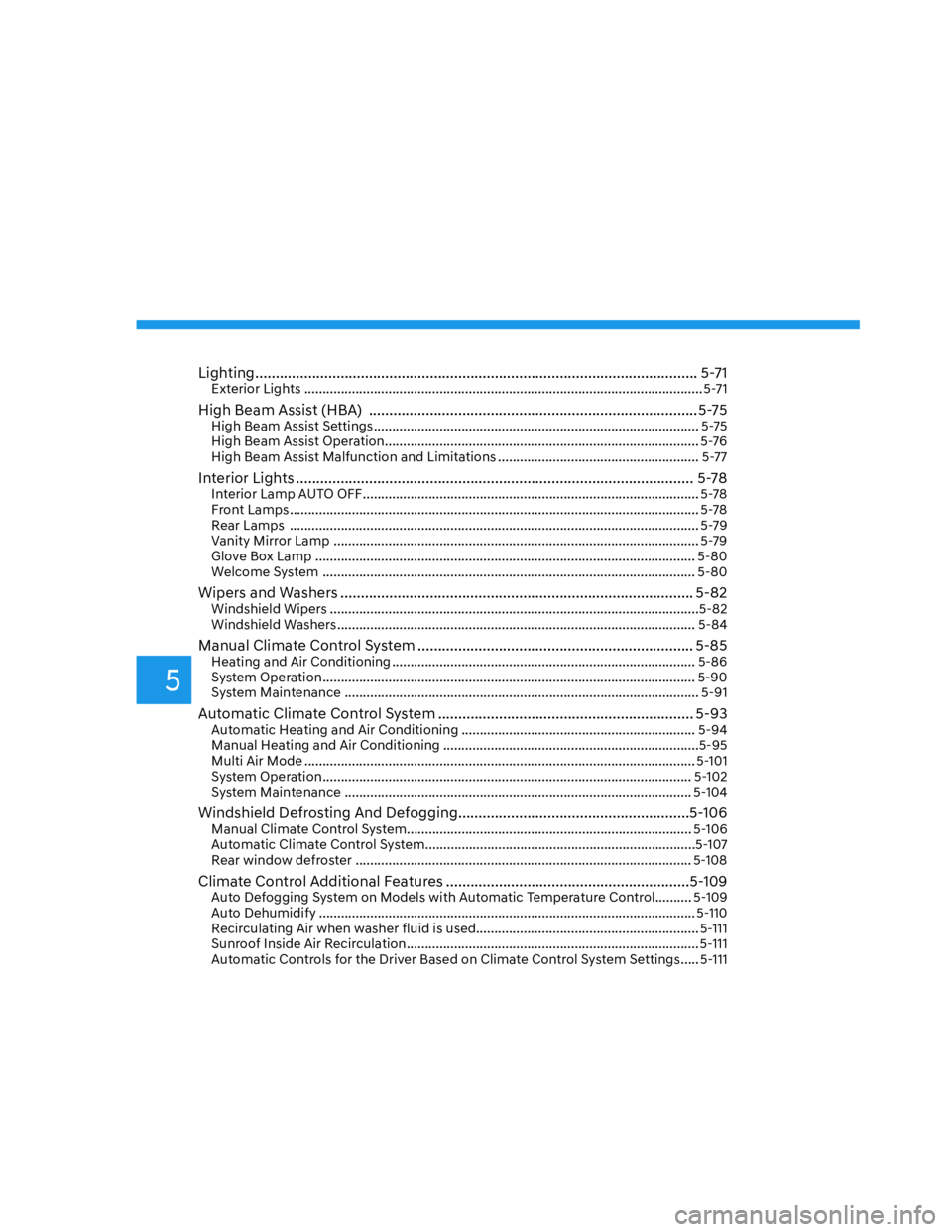
5
Lighting ............................................................................................................. 5-71Exterior Lights ............................................................................................................. 5-71
High Beam Assist (HBA) .................................................................................5-75High Beam Assist Settings ......................................................................................... 5-75
High Beam Assist Operation ...................................................................................... 5-76
High Beam Assist Malfunction and Limitations ....................................................... 5-77
Interior Lights .................................................................................................. 5-78Interior Lamp AUTO OFF ............................................................................................ 5-78
Front Lamps ................................................................................................................ 5-78
Rear Lamps ................................................................................................................ 5-79
Vanity Mirror Lamp .................................................................................................... 5-79
Glove Box Lamp ........................................................................................................ 5-80
Welcome System ...................................................................................................... 5-80
Wipers and Washers ....................................................................................... 5-82Windshield Wipers .....................................................................................................5-82
Windshield Washers .................................................................................................. 5-84
Manual Climate Control System .................................................................... 5-85Heating and Air Conditioning ................................................................................... 5-86
System Operation ...................................................................................................... 5-90
System Maintenance ................................................................................................. 5-91
Automatic Climate Control System ............................................................... 5-93Automatic Heating and Air Conditioning ................................................................ 5-94
Manual Heating and Air Conditioning ......................................................................5-95
Multi Air Mode ........................................................................................................... 5-101
System Operation ..................................................................................................... 5-102
System Maintenance ............................................................................................... 5-104
Windshield Defrosting And Defogging .........................................................5-106
Manual Climate Control System.............................................................................. 5-106
Automatic Climate Control System..........................................................................5-107
Rear window defroster ............................................................................................ 5-108
Climate Control Additional Features ............................................................5-109Auto Defogging System on Models with Automatic Temperature Control .......... 5-109
Auto Dehumidify ....................................................................................................... 5-110
Recirculating Air when washer fluid is used ............................................................. 5-111
Sunroof Inside Air Recirculation ................................................................................ 5-111
Automatic Controls for the Driver Based on Climate Control System Settings ..... 5-111
Page 141 of 598
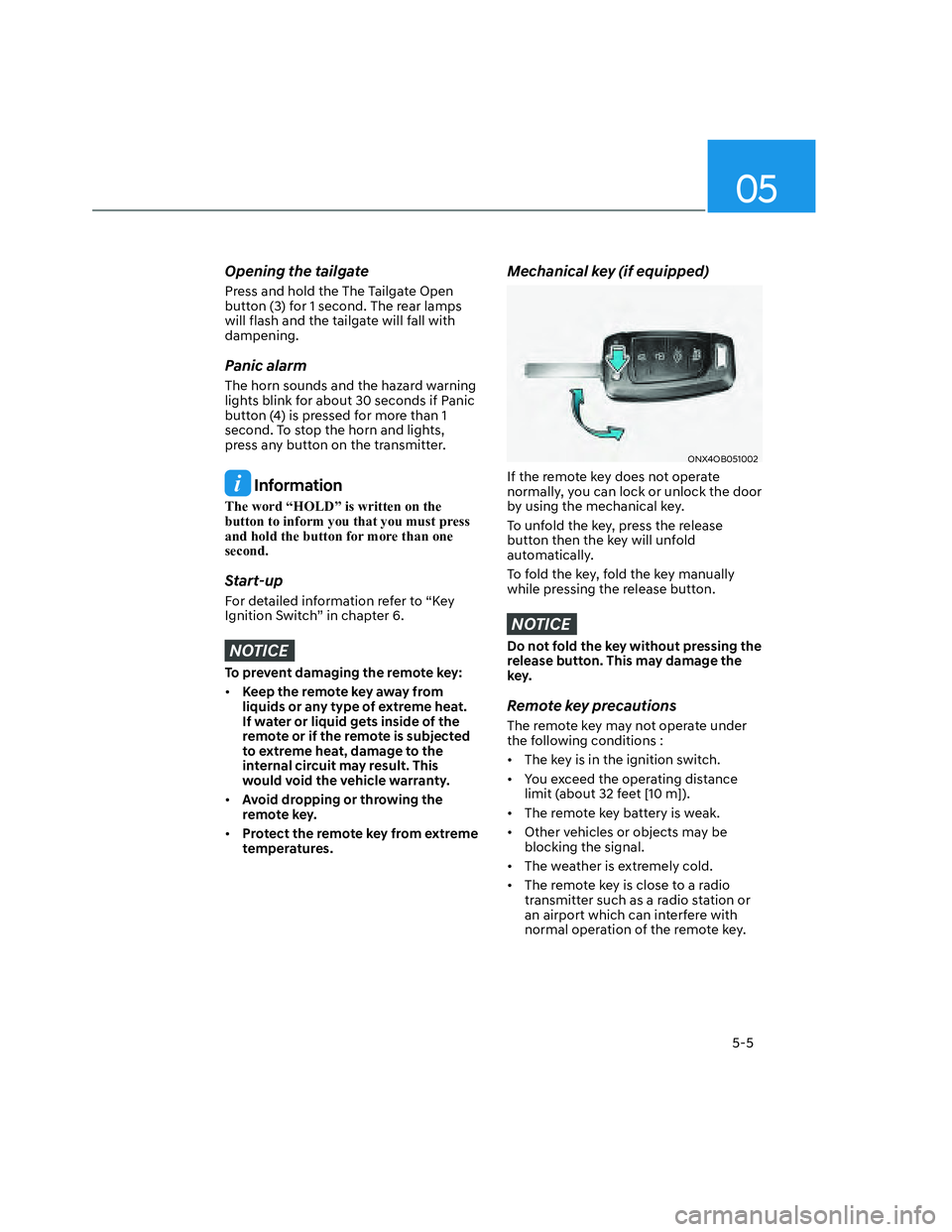
05
5-5
Opening the tailgate
Press and hold the The Tailgate Open
button (3) for 1 second. The rear lamps
will flash and the tailgate will fall with
dampening.
Panic alarm
The horn sounds and the hazard warning
lights blink for about 30 seconds if Panic
button (4) is pressed for more than 1
second. To stop the horn and lights,
press any button on the transmitter.
Information
The word “HOLD” is written on the
button to inform you that you must press
and hold the button for more than one
second.
Start-up
For detailed information refer to “Key
Ignition Switch” in chapter 6.
NOTICE
To prevent damaging the remote key:
• Keep the remote key away from
liquids or any type of extreme heat.
If water or liquid gets inside of the
remote or if the remote is subjected
to extreme heat, damage to the
internal circuit may result. This
would void the vehicle warranty.
• Avoid dropping or throwing the
remote key.
• Protect the remote key from extreme
temperatures.
Mechanical key (if equipped)
ONX4OB051002ONX4OB051002
If the remote key does not operate
normally, you can lock or unlock the door
by using the mechanical key.
To unfold the key, press the release
button then the key will unfold
automatically.
To fold the key, fold the key manually
while pressing the release button.
NOTICE
Do not fold the key without pressing the
release button. This may damage the
key.
Remote key precautions
The remote key may not operate under
the following conditions :
• The key is in the ignition switch.
• You exceed the operating distance
limit (about 32 feet [10 m]).
• The remote key battery is weak.
• Other vehicles or objects may be
blocking the signal.
• The weather is extremely cold.
• The remote key is close to a radio
transmitter such as a radio station or
an airport which can interfere with
normal operation of the remote key.
Page 167 of 598
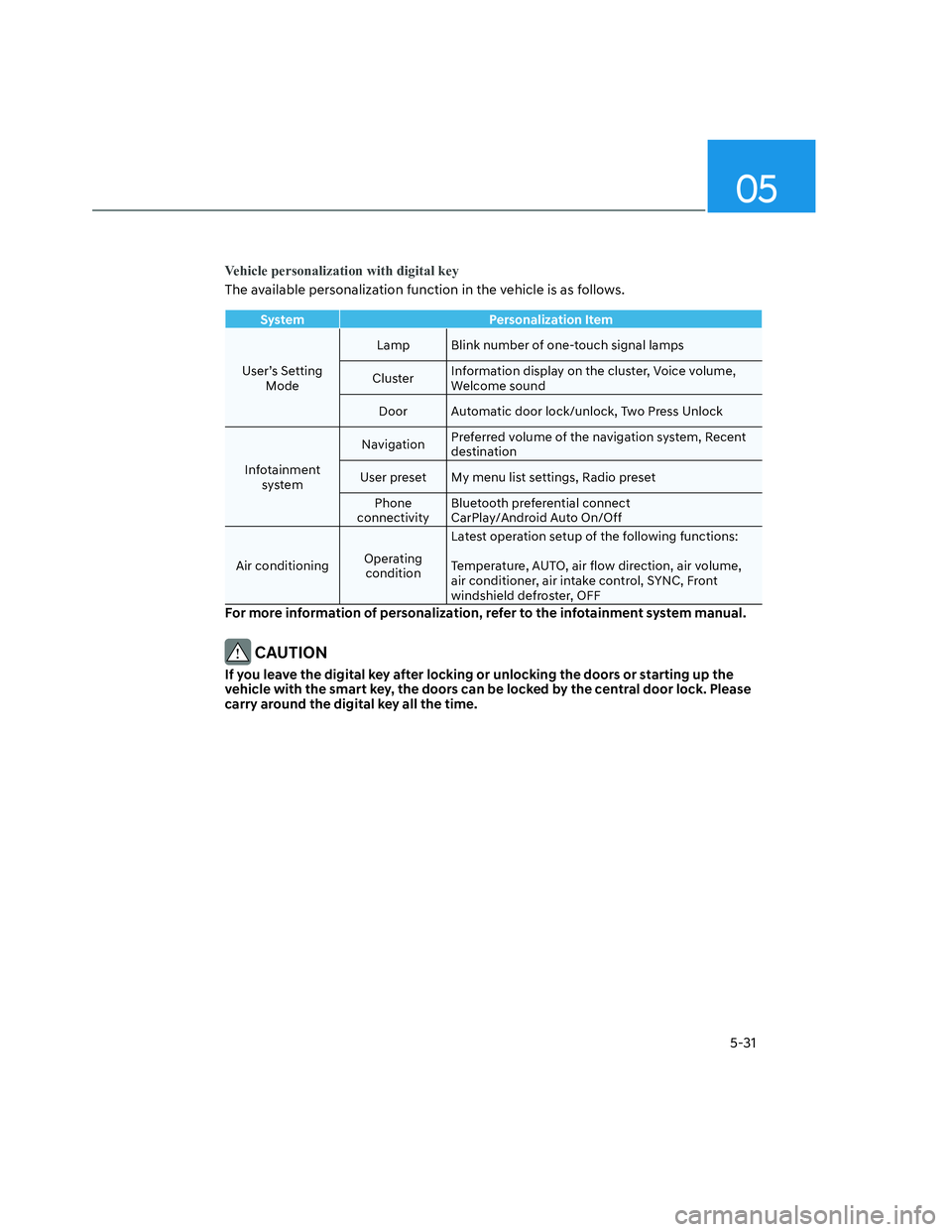
05
5-31
Vehicle personalization with digital key
The available personalization function in the vehicle is as follows.
System Personalization Item
User’s Setting
ModeLamp Blink number of one-touch signal lamps
ClusterInformation display on the cluster, Voice volume,
Welcome sound
Door Automatic door lock/unlock, Two Press Unlock
Infotainment
systemNavigationPreferred volume of the navigation system, Recent
destination
User preset My menu list settings, Radio preset
Phone
connectivityBluetooth preferential connect
CarPlay/Android Auto On/Off
Air conditioningOperating
conditionLatest operation setup of the following functions:
Temperature, AUTO, air flow direction, air volume,
air conditioner, air intake control, SYNC, Front
windshield defroster, OFF
For more information of personalization, refer to the infotainment system manual.
CAUTION
If you leave the digital key after locking or unlocking the doors or starting up the
vehicle with the smart key, the doors can be locked by the central door lock. Please
carry around the digital key all the time.
Page 186 of 598
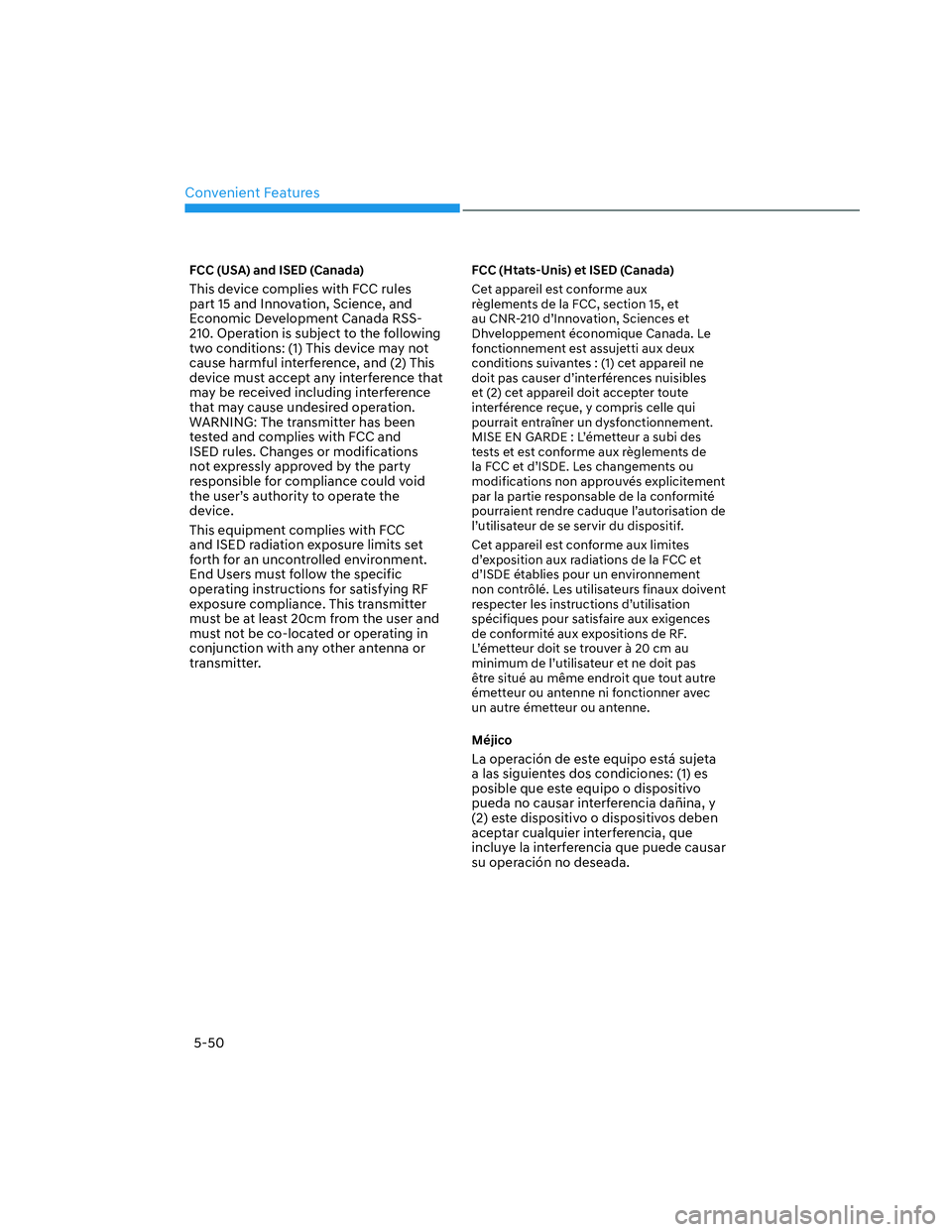
Convenient Features
5-50
FCC (USA) and ISED (Canada)
This device complies with FCC rules
part 15 and Innovation, Science, and
Economic Development Canada RSS-
210. Operation is subject to the following
two conditions: (1) This device may not
cause harmful interference, and (2) This
device must accept any interference that
may be received including interference
that may cause undesired operation.
WARNING: The transmitter has been
tested and complies with FCC and
ISED rules. Changes or modifications
not expressly approved by the party
responsible for compliance could void
the user’s authority to operate the
device.
This equipment complies with FCC
and ISED radiation exposure limits set
forth for an uncontrolled environment.
End Users must follow the specific
operating instructions for satisfying RF
exposure compliance. This transmitter
must be at least 20cm from the user and
must not be co-located or operating in
conjunction with any other antenna or
transmitter.
FCC (Htats-Unis) et ISED (Canada)
Cet appareil est conforme aux
règlements de la FCC, section 15, et
au CNR-210 d’Innovation, Sciences et
Dhveloppement économique Canada. Le
fonctionnement est assujetti aux deux
conditions suivantes : (1) cet appareil ne
doit pas causer d’interférences nuisibles
et (2) cet appareil doit accepter toute
interférence reçue, y compris celle qui
pourrait entraîner un dysfonctionnement.
MISE EN GARDE : L’émetteur a subi des
tests et est conforme aux règlements de
la FCC et d’ISDE. Les changements ou
modifications non approuvés explicitement
par la partie responsable de la conformité
pourraient rendre caduque l’autorisation de
l’utilisateur de se servir du dispositif.
Cet appareil est conforme aux limites
d’exposition aux radiations de la FCC et
d’ISDE établies pour un environnement
non contrôlé. Les utilisateurs finaux doivent
respecter les instructions d’utilisation
spécifiques pour satisfaire aux exigences
de conformité aux expositions de RF.
L’émetteur doit se trouver à 20 cm au
minimum de l’utilisateur et ne doit pas
être situé au même endroit que tout autre
émetteur ou antenne ni fonctionner avec
un autre émetteur ou antenne.
Méjico
La operación de este equipo está sujeta
a las siguientes dos condiciones: (1) es
posible que este equipo o dispositivo
pueda no causar interferencia dañina, y
(2) este dispositivo o dispositivos deben
aceptar cualquier interferencia, que
incluye la interferencia que puede causar
su operación no deseada.